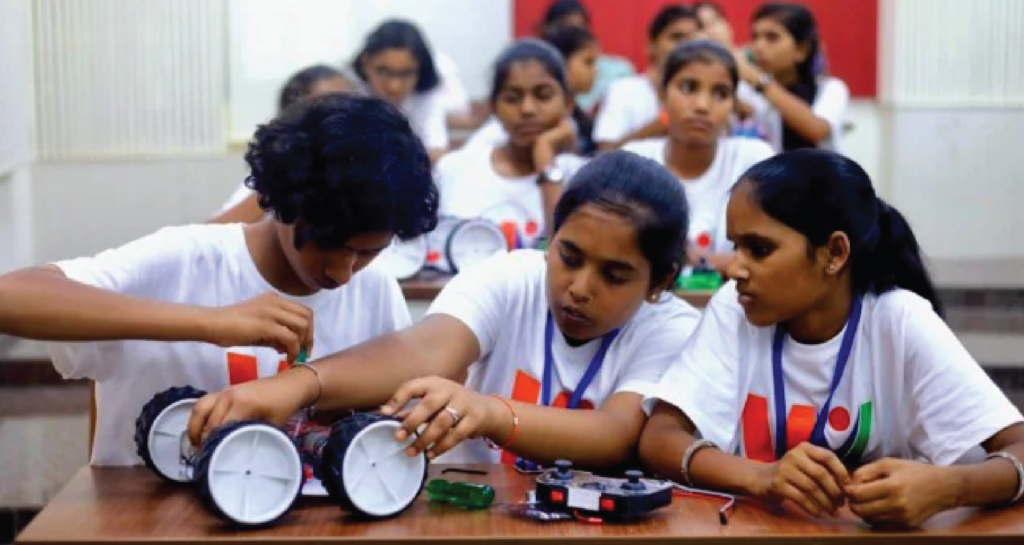In a world that is changing quickly, the gender gap in STEM (science, technology, engineering, and mathematics) disciplines continues to be a serious problem that impedes advancement. Even while the value of diversity and inclusion is becoming more widely acknowledged, obstacles still prevent women and members of underrepresented groups from participating fully in these vital fields. Closing this disparity is crucial for promoting fairness as well as realizing the full creative and problem-solving potential of different viewpoints. This essay examines the obstacles posed by the gender gap in STEM and identifies practical tactics for promoting increased inclusion and diversity in the sector.
Girls’ participation in STEM education is essential because, in addition to promoting diversity and innovation, they act as significant role models for the workforce of the future. Their work acts as a spark for innovations that transform entire sectors of the economy and open doors for the next generations. Girls in STEM have always advanced the discipline with their expertise, inventiveness, and perspectives—from Marie Curie’s groundbreaking discoveries to the accomplishments of modern female scientists, engineers, and technicians. In this sense, the growth of STEM areas and STEM education is now greatly influenced by the participation of women.
Becoming Aware of the STEM Gender Gap
Understanding the gender gap in STEM fields is essential to building a more inventive and fair future. Despite their ability to provide important views and answers, women and under-represented groups are still notably underrepresented in STEM education and jobs. This knowledge contributes to shedding light on the institutionalized prejudices and barriers—such as a lack of role models, social preconceptions, and insufficient support networks—that discourage many people from pursuing these careers. Recognizing the gender gap enables politicians, companies, and educators to launch focused programs that support diversity and inclusiveness. We may endeavor to create a STEM environment that is more vibrant and balanced by addressing these problems.
Prejudices and cultural perspectives have a big impact on how many females participate in and are represented in STEM fields. Cultural prejudices and presumptions that STEM areas are more suited for men provide obstacles for girls seeking STEM education. Girls are under-represented in STEM professions, which is made worse by a lack of knowledge about mentors and role models in these disciplines. In order to address the problem, programs that encourage STEM education for females and motivate them to seek employment in the area are needed. We can assist women in succeeding in STEM fields and closing the gender gap by questioning social conventions and creating supportive environments.
The Value of Diversity in STEM Fields
Increased Creativity and Innovation: Diverse teams bring a range of viewpoints, backgrounds, and methods of problem-solving to the table. This intellectual variety encourages creativity since people may dispute one another’s theories and work together to come up with original solutions. According to research, companies with diverse teams are more likely to create innovative goods and services that advance STEM sectors.
Better Decision-Making: Because diverse groups take a larger range of experiences and points of view into account, they often make better judgments. This thorough approach leads to better informed and efficient results by assisting in the identification of possible hazards and other solutions. In STEM, diverse teams can improve the caliber of decision-making processes since complex challenges call for nuanced understanding.
Role models and representation: Diversifying the STEM fields is essential to improving representation. When people from different backgrounds see themselves represented in these disciplines, misconceptions are dispelled, and more people are inspired to pursue STEM jobs. The next generation of scientists, engineers, and technicians can be motivated by varied role models, which can also provide marginalized groups with a feeling of potential and belonging.
Economic Growth and Competitiveness: By increasing the talent pool and fostering innovation, embracing diversity in STEM fields helps to boost economic growth and competitiveness. Diverse workforces are better able to adjust to shifting demands and satisfy the expectations of a global market. Through the utilization of diverse individuals’ abilities, organizations may improve their competitiveness and promote long-term economic success.
Social Equity and Inclusion: In order to achieve social equity, diversity in STEM fields must be encouraged. Equal chances for all people, irrespective of their gender, color, or socioeconomic status, can help us move toward a more inclusive society. In addition to helping individuals, addressing the gender gap and other inequalities in STEM professions also enriches communities and improves the general well-being of society.
Encouraging Female Participation in STEM
Promoting female involvement in STEM fields necessitates a diverse strategy. Girls’ interest in STEM subjects must be piqued and core abilities must be built early on. In order to provide stimulating settings for females to explore, schools and community organizations can provide hands-on activities like scientific experiments, coding workshops, and engineering challenges. Making connections between female STEM mentors and girls can have a big influence on the girls’ career goals. While displaying successful female role models through events and media coverage might motivate girls to picture themselves in STEM fields, mentoring programs that match students with experts offer important help.
It is crucial to create an inclusive STEM curriculum that tackles gender prejudices. Teachers ought to use gender-sensitive teaching strategies that encourage teamwork and give females the chance to take the lead on projects, which will increase their self-esteem. Forming alliances with neighborhood groups may help establish networks of support, and neighborhood gatherings like STEM fairs and seminars provide access to more resources for learning.
Financial obstacles to STEM education can be reduced by offering scholarships and other financial incentives exclusively to female students. Lastly, systemic change requires support for laws that advance gender parity in STEM fields. By tackling these issues, we can close the gender gap and promote a varied, creative future in science and technology by greatly increasing the number of women pursuing STEM degrees.
Encouraging Diversity in STEM Employment
Encouraging diversity in STEM fields is crucial for fostering creativity and achieving organizational success. Important tactics consist of:
Inclusive Hiring Practices: To attract diverse talent, expand recruitment efforts to under-represented groups, utilize diverse interview panels, and develop internship programs specifically targeted at these demographics.
Establishing a Supportive Workplace Culture: Encourage an open line of communication, offer diversity training, and hold events to honor the diversity of backgrounds in order to create an inclusive workplace culture where all employees feel appreciated.
Mentorship and Sponsorship Programs: Create mentorship and sponsorship programs to provide direction and networking to under-represented employees as they navigate their jobs and seek out possibilities for growth.
Flexible Work Arrangements: To meet a range of demands and draw in a larger talent pool, provide flexible work choices, including remote work and flexible hours.
Constant Training and Development: Make an investment in professional development and training that is centered on diversity, equity, and inclusion, in addition to pertinent technical skills.
Establishing Diversity Goals and Metrics: To guarantee responsibility and openness in diversity initiatives, clearly define your goals and evaluate your progress on a regular basis.
To sum up, encouraging females to pursue STEM fields is critical to improving future leadership, diversity, and creativity. Women in STEM fields drive progress and inspire the next generation by being role models. Closing the gender gap contributes to a fairer future because different viewpoints improve problem-solving and innovation. Girls are empowered by programs that offer mentoring and early STEM exposure. Businesses may boost economic development and enhance decision-making by encouraging diversity in STEM fields. In the end, closing the gender gap will promote social fairness and create a society that is more inventive.




